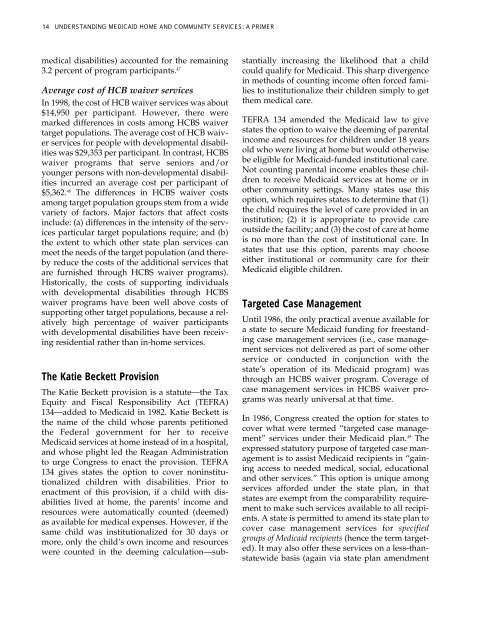Full PDF Version - ASPE - U.S. Department of Health and Human ...
Full PDF Version - ASPE - U.S. Department of Health and Human ...
Full PDF Version - ASPE - U.S. Department of Health and Human ...
- No tags were found...
Create successful ePaper yourself
Turn your PDF publications into a flip-book with our unique Google optimized e-Paper software.
14 UNDERSTANDING MEDICAID HOME AND COMMUNITY SERVICES: A PRIMERmedical disabilities) accounted for the remaining3.2 percent <strong>of</strong> program participants. 47Average cost <strong>of</strong> HCB waiver servicesIn 1998, the cost <strong>of</strong> HCB waiver services was about$14,950 per participant. However, there weremarked differences in costs among HCBS waivertarget populations. The average cost <strong>of</strong> HCB waiverservices for people with developmental disabilitieswas $29,353 per participant. In contrast, HCBSwaiver programs that serve seniors <strong>and</strong>/oryounger persons with non-developmental disabilitiesincurred an average cost per participant <strong>of</strong>$5,362. 48 The differences in HCBS waiver costsamong target population groups stem from a widevariety <strong>of</strong> factors. Major factors that affect costsinclude: (a) differences in the intensity <strong>of</strong> the servicesparticular target populations require; <strong>and</strong> (b)the extent to which other state plan services canmeet the needs <strong>of</strong> the target population (<strong>and</strong> therebyreduce the costs <strong>of</strong> the additional services thatare furnished through HCBS waiver programs).Historically, the costs <strong>of</strong> supporting individualswith developmental disabilities through HCBSwaiver programs have been well above costs <strong>of</strong>supporting other target populations, because a relativelyhigh percentage <strong>of</strong> waiver participantswith developmental disabilities have been receivingresidential rather than in-home services.The Katie Beckett ProvisionThe Katie Beckett provision is a statute—the TaxEquity <strong>and</strong> Fiscal Responsibility Act (TEFRA)134—added to Medicaid in 1982. Katie Beckett isthe name <strong>of</strong> the child whose parents petitionedthe Federal government for her to receiveMedicaid services at home instead <strong>of</strong> in a hospital,<strong>and</strong> whose plight led the Reagan Administrationto urge Congress to enact the provision. TEFRA134 gives states the option to cover noninstitutionalizedchildren with disabilities. Prior toenactment <strong>of</strong> this provision, if a child with disabilitieslived at home, the parents’ income <strong>and</strong>resources were automatically counted (deemed)as available for medical expenses. However, if thesame child was institutionalized for 30 days ormore, only the child’s own income <strong>and</strong> resourceswere counted in the deeming calculation—substantiallyincreasing the likelihood that a childcould qualify for Medicaid. This sharp divergencein methods <strong>of</strong> counting income <strong>of</strong>ten forced familiesto institutionalize their children simply to getthem medical care.TEFRA 134 amended the Medicaid law to givestates the option to waive the deeming <strong>of</strong> parentalincome <strong>and</strong> resources for children under 18 yearsold who were living at home but would otherwisebe eligible for Medicaid-funded institutional care.Not counting parental income enables these childrento receive Medicaid services at home or inother community settings. Many states use thisoption, which requires states to determine that (1)the child requires the level <strong>of</strong> care provided in aninstitution; (2) it is appropriate to provide careoutside the facility; <strong>and</strong> (3) the cost <strong>of</strong> care at homeis no more than the cost <strong>of</strong> institutional care. Instates that use this option, parents may chooseeither institutional or community care for theirMedicaid eligible children.Targeted Case ManagementUntil 1986, the only practical avenue available fora state to secure Medicaid funding for freest<strong>and</strong>ingcase management services (i.e., case managementservices not delivered as part <strong>of</strong> some otherservice or conducted in conjunction with thestate’s operation <strong>of</strong> its Medicaid program) wasthrough an HCBS waiver program. Coverage <strong>of</strong>case management services in HCBS waiver programswas nearly universal at that time.In 1986, Congress created the option for states tocover what were termed “targeted case management”services under their Medicaid plan. 49 Theexpressed statutory purpose <strong>of</strong> targeted case managementis to assist Medicaid recipients in “gainingaccess to needed medical, social, educational<strong>and</strong> other services.” This option is unique amongservices afforded under the state plan, in thatstates are exempt from the comparability requirementto make such services available to all recipients.A state is permitted to amend its state plan tocover case management services for specifiedgroups <strong>of</strong> Medicaid recipients (hence the term targeted).It may also <strong>of</strong>fer these services on a less-thanstatewidebasis (again via state plan amendment
















